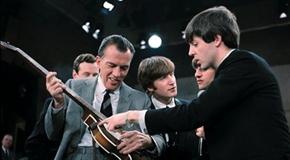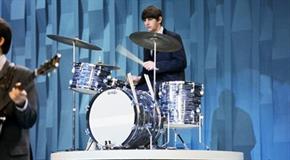Memories Of The Beatles’ US Television Debut
The Beatles made their first appearance on “The Ed Sullivan Show,” America’s must-see weekly variety show, on Sunday, Feb. 9, 1964. And officially kicked off Beatlemania on this side of the pond.
More than 70 million viewers were tuned to the program, airing live from the Manhattan studio now housing the “Late Show With David Letterman.”
Here are recollections from some notable viewers and participants – including one Beatle.

Charlie Brill and Mitzi McCall were an up-and-coming husband-and-wife comedy team that specialized in carefully crafted character sketches. They were thrilled when they landed their first appearance on “Sullivan.”
Unfortunately, they were booked on that first Beatles show – slotted just before the Beatles hit the stage for their second set. Needless to say, the studio audience – packed with teenage girls – wasn’t interested in watching grown-ups doing comedy.
Charlie Brill: “Mr. Sullivan called us into his dressing room after dress rehearsal. He said, ‘You’re doing a very sophisticated piece of business and my audience is 14-year-old girls. They won’t understand it. So why don’t you show me everything you have, and we’ll rebuild your whole act.’“
MM: “The biggest laugh we got was when I ad-libbed, ‘I was backstage and I stepped on a beetle.’“
CB: “That got a roar.”
MM: “And I thought, ‘Oh, boy, are we in trouble!’“
CB: “After we finished, we stood in the wings and watched, but I couldn’t hear anything. The screaming from the audience was so intense that I didn’t even know what the Beatles were doing.”
MM: “Now I feel like it was an honor to be on that show with them, but our performance wasn’t what we wanted it to be. We never look at the recording of it.”

At age 29, Vince Calandra was a rising young program coordinator on “The Ed Sullivan Show” whose many duties included, on one notable weekend, looking after four musical guests.
Fortunately, he was versatile.
“George was sick. He had a 102-degree temperature,” says Calandra. “So he didn’t come to the rehearsal that Saturday, and I stood in for him wearing a Beatles wig. When McCartney saw me with a guitar in my hand and a wig, he had a kind of look like, ‘I’m glad you have a day job, ‘cause you just don’t look the part.’“
Standing just offstage for their performance that Sunday night, Calandra describes the sensation as “unnn-believable! Pannnn-demonium! You couldn’t hear anything for the screaming.”
The show culminated a long day at the theater, where the Beatles had arrived that morning.
“During the day, John seemed nervous, and basically sat around and doodled,” Calandra says, “and kept asking for change for the Coke machine. Ringo was reading ‘Green Hornet’ and watching TV.
“They were all very professional, very respectful,” sums up Calandra, who went on to have a long career as a producer. “They weren’t like other groups that came in, whose attitude was, ‘OK, let’s do the “Sullivan Show” and sell a bunch of records and then on Monday morning we’re all gonna go to the dealership and buy our new cars.’ The Beatles really wanted this thing to work!”

Leslie Moonves was a teenager growing up on Long Island, N.Y., with no idea that he would one day run the network he was tuned to for “Ed Sullivan.”
In fact, just days before the historic broadcast, the CBS chairman and CEO had no idea whom the Beatles were.
“I remember the first time I heard the word ‘Beatles,’“ he recalls. “It was that Friday. I was in seventh grade and my best friend, who was really into music, said, ‘You gotta watch them, they’re on “The Ed Sullivan Show” on Sunday night.’
“I said, ‘Really? There’s a group called the Beatles?’ It sounded gross.
“But I watched, and I saw this unbelievable crowd reaction to these guys. And at school the next day, the Beatles were all anybody was talking about. And I felt very cool, because I had seen it. But three days earlier, I hadn’t heard of them.”
These days, the Ed Sullivan theater is familiar territory for Moonves.
“I’ve done a number of presentations for advertisers from that stage,” he says, adding that his mind immediately goes to the Fab Four. “(I think), ‘The Beatles were here! The Beatles were here!’ On these very planks beneath my feet.”

Even Ringo Starr didn’t know the magnitude of what was about to happen when he played with his bandmates that night.
“Incredible!” he recalls. “It was ‘Ed Sullivan,’ it was a big show. We didn’t know while we were playing that 70 million people were watching, but it was being in America that was so exciting.
“All the music we loved was in America, it came from America to England.”
While holed up at their Manhattan hotel, they were interviewed by the city’s leading deejays, which, all by itself, was an amazing experience.
“With Murray the K and Cousin Brucie, we were on the radio – we were in the hotel rooms on the phone to Murray the K. You didn’t have anything like that in England. The whole experience was just incredible.”
CBS anchor Walter Cronkite scored tickets to the “Sullivan Show” for his teenage daughters Nancy and Kathy.
“The Beatles were already huge, and huge to me – monumental!” Kathy Cronkite says. “The idea of seeing them in person was like going to another planet. And when we got there we were screaming our heads off, so we couldn’t hear the music.
“Then, afterward, we got to meet them,” she adds. “They were very nice. They put their arms around us for a picture, which was really fabulous. Ringo and I happened to be standing next to each other, and he was MY Beatle. So that was especially exciting.”
For Cronkite, a former actress who appeared in the classic film “Network” but is now a mental-health advocate, many of the details have vanished with the passage of time.
“In the scope of the rest of my life, it has faded in significance somewhat,” she says, but takes pains to emphasize, “I don’t mean it wasn’t important. At the time it was absolutely huge. And back then, when I was 13, I’m sure I thought it was the main thing that would EVER matter.”

Pat Dinizio, lead singer of the New Jersey-based rock band the Smithereens, not only remembers seeing the Beatles on “Sullivan,” but also vividly recalls the first moment he heard their music.
He was 8 years old, brushing his teeth with his red transistor radio on when the disc jockey announced he was playing “I Want to Hold Your Hand.” Stunned by the sound, he dropped the toothbrush. He watched the show from the living room of his home in Scotch Plains, N.J., with his parents.
“I wanted to be them. I wanted to do what they did. I wanted to have my haircut like that and I wanted to be in a rock ‘n’ roll band,” he says. “That was a major, major important event for the youth of America. My parents couldn’t have been over 30 years old and they didn’t dig the Beatles too much. They didn’t dig the long hair.”
In 2006, the Smithereens released Meet the Smithereens, a note-for-note remake of “Meet the Beatles,” which was a strong seller online because the Beatles’ music wasn’t available through iTunes at the time. The Smithereens just released a new disc that is a run-through of the songs the Beatles played during their first concert on American soil, in Washington, D.C., on Feb. 11, 1964.
Singer-songwriter Rosanne Cash, Johnny’s daughter, was 8 years old in 1964. She lived in southern California with her mother, Vivian, who was separated from Johnny by then.
“I loved the Beatles so much it was physically painful,” she says. “I knew they were going to be on ‘Ed Sullivan’ and I counted the minutes. When it was time, I sat in front of the television at least a half-hour before the show started because I was anxious that I might miss even a single second.
“When they were about to come on, my mother kept my sisters in the kitchen to keep them quiet, and I overheard her say, ‘SHHH. Rosanne is watching the Beatles.’ It was one of the greatest things my mom ever did for me.”
Cash has recorded versions of the Beatles’ songs “I’m Only Sleeping” and “I Don’t Want to Spoil the Party.”
 Daily Pulse
Subscribe
Daily Pulse
Subscribe

